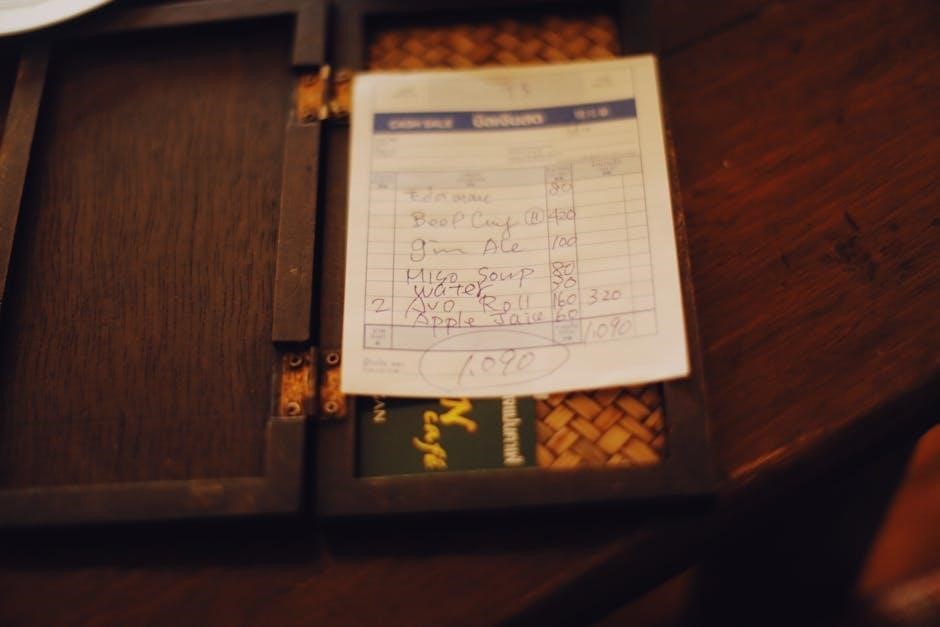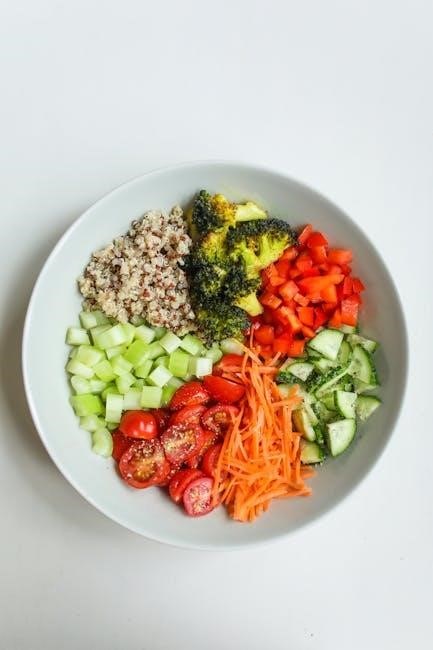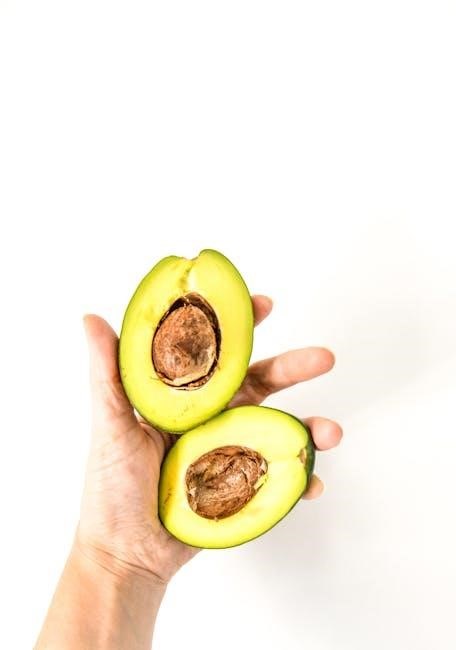
The Glycemic Index (GI) is a scale measuring how carbohydrate-containing foods affect blood sugar levels; It ranks foods from 0 to 100, with pure glucose as the reference. A low GI indicates slower digestion and gradual blood sugar increases, while high GI foods cause rapid spikes. Understanding the GI helps manage conditions like diabetes and supports balanced nutrition by identifying foods that maintain stable energy levels and prevent sudden cravings.
1.1 What is the Glycemic Index (GI)?
The Glycemic Index (GI) is a numerical scale that measures how quickly foods raise blood sugar levels after consumption. It ranks foods on a scale from 0 to 100, with pure glucose as the reference point (GI = 100). Foods are categorized as low GI (55 or less), medium GI (56–69), or high GI (70 or more). The GI reflects the digestion rate of carbohydrates, with low GI foods breaking down slowly, causing gradual blood sugar increases. This index is essential for managing conditions like diabetes and promoting balanced nutrition by helping individuals identify foods that stabilize energy levels and prevent sudden cravings. Understanding the GI aids in making informed dietary choices for better health outcomes.
1.2 Importance of GI in Diet and Health
The Glycemic Index (GI) plays a crucial role in diet and health by helping individuals manage blood sugar levels. Foods with a low GI promote gradual increases in blood glucose, reducing the risk of spikes and crashes. This is particularly beneficial for people with diabetes, as it aids in maintaining stable blood sugar levels and preventing complications. Beyond blood sugar control, a low GI diet supports weight management by increasing satiety and reducing overall calorie intake, which can contribute to weight loss and maintenance. Additionally, incorporating low GI foods into one’s diet may enhance heart health by lowering cholesterol levels and improving insulin sensitivity, thereby reducing the risk of cardiovascular diseases. Understanding and applying GI values can lead to better dietary choices, promoting long-term health benefits.

Categories of GI Ratings
Foods are categorized into three GI ratings: Low (55 or less), Medium (56–69), and High (70 or more). These ratings indicate how quickly foods raise blood sugar.
2.1 Low GI Foods (55 or Less)
Low GI foods have a glycemic index of 55 or less, meaning they digest slowly and cause gradual blood sugar increases. Examples include whole grains like oats and barley, non-starchy vegetables such as broccoli and spinach, and most fruits like apples and berries. Legumes like lentils and chickpeas, as well as dairy products like yogurt and milk, are also low GI. These foods are rich in fiber and nutrients, making them ideal for maintaining blood sugar stability and promoting overall health. Incorporating them into meals helps prevent energy crashes and supports better insulin regulation.
2.2 Medium GI Foods (56–69)
Medium GI foods have a glycemic index between 56 and 69, causing a moderate rise in blood sugar levels. Examples include whole grains like brown rice and couscous, starchy vegetables such as sweet potatoes and corn, and certain fruits like bananas and grapes. These foods are less likely to cause sharp blood sugar spikes compared to high GI foods but should still be consumed in moderation, especially by those monitoring their glucose levels. Incorporating medium GI foods into meals can provide essential nutrients while maintaining balanced blood sugar control, making them a practical choice for overall health and wellness.
2.3 High GI Foods (70 or More)
High GI foods have a glycemic index of 70 or more, causing significant and rapid increases in blood sugar levels. These include refined carbohydrates like white bread, sugary snacks, and processed foods. Consuming high GI foods can lead to energy crashes and increased hunger shortly after eating due to the sharp insulin spikes they trigger. Over time, regular intake of high GI foods may contribute to health issues such as insulin resistance and type 2 diabetes. It is generally recommended to limit these foods, especially for individuals managing blood sugar conditions, and opt for lower GI alternatives to maintain better metabolic health and stability.

Benefits of Low GI Foods
Low GI foods stabilize blood sugar levels, reduce cravings, and improve heart health by minimizing blood sugar spikes and promoting sustained energy release.
3.1 Blood Sugar Management
Low GI foods are essential for maintaining stable blood sugar levels. By digesting slowly, they prevent sudden spikes in glucose, reducing insulin surges. This is particularly beneficial for individuals with diabetes or prediabetes, as it helps avoid complications like hyperglycemia. Incorporating low GI options into meals can minimize the risk of blood sugar fluctuations, promoting better metabolic health. Foods such as whole grains, legumes, and non-starchy vegetables release glucose gradually, ensuring a steady energy supply. This balanced approach supports long-term blood sugar management and overall well-being.

3.2 Weight Management
Low GI foods play a significant role in weight management by promoting satiety and stabilizing blood sugar levels. They digest slowly, keeping you fuller for longer and reducing the likelihood of overeating. This can lead to natural calorie reduction, aiding in weight loss. Additionally, low GI diets often emphasize whole, unprocessed foods, which tend to be lower in calories and higher in nutrients. By choosing options like whole grains, legumes, and vegetables, individuals can maintain a healthy weight and reduce the risk of obesity-related conditions. This approach supports sustainable weight management without extreme calorie restriction, fostering a balanced lifestyle.
3.3 Heart Health Benefits
Low GI foods contribute significantly to heart health by reducing inflammation and improving blood lipid profiles. Their slow digestion prevents sharp spikes in blood sugar, lowering insulin resistance and the risk of cardiovascular diseases. These foods are often rich in fiber, which helps lower LDL cholesterol and regulate blood pressure. A diet rich in whole grains, vegetables, and legumes supports overall heart health. Additionally, the steady energy release from low GI foods reduces the need for excessive calorie intake, further benefiting heart health. Incorporating these foods into your diet can help maintain a healthy heart and reduce the risk of chronic conditions.


List of Low GI Foods
Low GI foods include whole grains, legumes, non-starchy vegetables, low-GI fruits, and dairy products. These foods are typically less processed and higher in fiber, promoting stable blood sugar levels and better overall health.
4.1 Whole Grains
Whole grains are excellent low GI foods, providing sustained energy and fiber. Examples include oats, quinoa, barley, and whole wheat bread. They contain nutrients like B vitamins, iron, and magnesium, supporting overall health while stabilizing blood sugar levels. Incorporating whole grains into meals helps regulate digestion and prevents sharp insulin spikes. Choose unprocessed forms like brown rice, whole grain pasta, and rye to maximize benefits. These grains are versatile and can be part of breakfast, lunch, or dinner, making them a great addition to a balanced, low GI diet. Their slow digestion keeps energy levels stable, reducing hunger and cravings throughout the day.
4.2 Legumes and Pulses
Legumes and pulses are excellent low GI foods, providing essential nutrients and fiber. Examples include lentils, chickpeas, black beans, and kidney beans, all with GI values under 50. These foods are rich in protein, vitamins, and minerals, making them a healthy choice for balanced meals. Their slow digestion helps stabilize blood sugar levels, reducing insulin spikes. Legumes are also versatile, fitting into soups, salads, and main dishes. They support heart health, improve digestion, and aid in weight management. Incorporating legumes into your diet is a practical way to enjoy the benefits of low GI foods while maintaining nutritional variety and satisfaction. They are a cornerstone of a healthy, balanced diet.
4.3 Non-Starchy Vegetables
Non-starchy vegetables are ideal low GI foods, offering numerous health benefits. They include options like broccoli, spinach, cucumbers, and bell peppers, all with GI values typically under 30. These vegetables are rich in vitamins, minerals, and antioxidants while being low in calories and carbohydrates. Their fiber content slows digestion, preventing rapid blood sugar spikes. Incorporating them into meals helps maintain stable energy levels and supports overall well-being. Non-starchy vegetables are versatile, fitting into salads, stir-fries, and side dishes. They also contribute to heart health and weight management, making them a nutritious addition to any low GI diet. Their low GI makes them a great choice for balancing blood sugar levels naturally.
4.4 Fruits with Low GI
Fruits with a low GI are excellent choices for maintaining blood sugar balance. Apples, berries, and citrus fruits like oranges and grapefruits typically have GI values below 50. These fruits are rich in fiber, which slows sugar absorption, preventing sharp blood sugar spikes. Their antioxidants and vitamins support overall health and immune function. Fruits like cherries and apricots are also low GI options, making them ideal for snacks or desserts. Incorporating these fruits into meals helps regulate blood glucose levels naturally, making them a key component of a low GI diet. They are also versatile, fitting easily into breakfasts, smoothies, or salads, while providing essential nutrients and energy without causing rapid insulin responses.
4.5 Dairy Products
Dairy products are excellent low GI options, offering sustained energy and blood sugar control. Milk and yogurt, especially those without added sugars, have GI values around 30-40. The protein and fat in these foods slow carbohydrate digestion, stabilizing blood glucose levels. Greek yogurt and cottage cheese are particularly good choices due to their high protein content, which further aids in blood sugar regulation. Incorporating these into meals and snacks can provide essential nutrients like calcium and vitamins while maintaining a balanced diet. Dairy products are versatile, fitting seamlessly into breakfast routines, smoothies, or as snacks, making them a valuable part of a low GI lifestyle. They support overall health and energy management effectively, without causing rapid insulin spikes. Additionally, they contribute to muscle repair and maintenance, making them ideal for active individuals.

Meal Planning with Low GI Foods
Plan balanced meals by combining high and low GI foods to stabilize blood sugar. Opt for whole grains, legumes, and non-starchy vegetables. Portion control is key.

5.1 Combining High and Low GI Foods
Combining high and low GI foods balances blood sugar levels by slowing digestion. Pair high GI foods like white bread with low GI options such as beans or avocado. This mix reduces the meal’s overall glycemic impact, preventing sharp insulin spikes. For example, adding a handful of almonds to a high GI fruit like banana stabilizes blood sugar. This approach helps maintain energy levels and supports overall metabolic health, making it easier to manage cravings and maintain a balanced diet.
5.2 Portion Control for Balanced Meals
Portion control is essential for maintaining balanced meals, especially when incorporating low GI foods. Even healthy foods, if overeaten, can disrupt blood sugar levels and calorie intake. Using smaller plates and measuring portions helps regulate consumption. Pairing low GI foods with protein or healthy fats further stabilizes blood sugar. For example, a small serving of quinoa (low GI) with grilled chicken and vegetables ensures a balanced meal. Tracking portion sizes prevents overeating and supports weight management. This practice, combined with low GI choices, promotes steady energy levels and overall health, making it easier to sustain a nutritious diet long-term.

Practical Tips for Incorporating Low GI Foods
Start with low GI breakfasts, swap high GI foods for low GI alternatives, and snack smart with options like nuts or non-starchy vegetables to maintain balanced blood sugar levels.
6.1 Starting Your Day with Low GI Breakfasts
Begin your morning with low GI breakfast options to stabilize blood sugar and energize your day. Include whole grains like oatmeal, barley, or quinoa, which are rich in fiber and digest slowly. Pair with proteins like eggs or Greek yogurt to balance your meal. Add nuts or seeds for healthy fats and extra fiber. Incorporate non-starchy vegetables like spinach or tomatoes into omelets or whole grain toast for added nutrients. Avoid high GI foods like white bread or sugary cereals, which can cause blood sugar spikes. Opt for whole, unprocessed foods to maintain steady energy levels throughout the morning. A printable low GI food list PDF can help you plan balanced breakfasts.
6.2 Snacking Smart with Low GI Options
Snacking smart with low GI options helps maintain stable blood sugar levels and prevents energy crashes. Choose snacks like fresh fruits (e.g., apples, berries), raw vegetables (carrots, cucumbers), or a handful of nuts (almonds, walnuts). Pairing protein or healthy fats with carbs, such as yogurt with berries or hard-boiled eggs with veggies, enhances satiety. Opt for whole grain crackers or toast with avocado or hummus for a balanced snack. Avoid sugary or refined snacks, which cause rapid blood sugar spikes. Refer to a printable low GI food list PDF for more ideas, ensuring your snacks are both nutritious and blood sugar-friendly. Portion control is key to maintaining a healthy diet.
6.3 Swapping High GI Foods for Low GI Alternatives
Swapping high GI foods for low GI alternatives is a simple way to improve blood sugar stability and overall dietary balance. Replace white bread with whole grain bread, white rice with quinoa, and sugary snacks with fresh fruits like apples or berries. Opt for legumes instead of pasta and choose non-starchy vegetables like broccoli over potatoes. Even small changes, like adding nuts or seeds to meals, can lower the glycemic impact. Use a printable low GI food list PDF to identify easy swaps and make informed choices. This approach helps maintain energy levels and supports long-term health goals without drastic dietary overhauls.

Resources for Low GI Foods
Access a printable low GI food list PDF for easy reference; Online tools and GI charts provide comprehensive databases to help identify and track low GI options effectively.
7.1 Printable Low GI Food List PDF
A printable low GI food list PDF is an essential tool for managing diets focused on blood sugar control. This guide categorizes foods by their glycemic index, helping users make informed choices. It includes whole grains, legumes, non-starchy vegetables, and dairy products, all known for their low GI values. The PDF is designed to be user-friendly, offering a quick reference for meal planning. By focusing on foods with a GI of 55 or less, individuals can maintain stable blood sugar levels and improve overall health. This resource is particularly beneficial for those with diabetes or prediabetes, aiding in symptom management and prevention.
7.2 Online Tools and GI Charts
Online tools and GI charts provide accessible resources for identifying low glycemic index foods. Websites offer searchable databases, allowing users to explore the GI values of various foods. These tools often include interactive charts, traffic light systems, and customizable lists. Many platforms categorize foods into green (low GI), yellow (medium GI), and red (high GI) zones, making it easier to make informed dietary choices. Additionally, some resources provide meal planning guides and recipes focused on low GI ingredients. These tools are invaluable for individuals managing blood sugar levels, offering practical support for creating balanced and healthy diets. They complement printable PDF guides, ensuring a comprehensive approach to GI-based eating.
Incorporating low GI foods into your diet promotes stable blood sugar levels, supports weight management, and enhances overall health. Utilize resources like printable PDF guides to plan balanced meals effectively.
8.1 Maximizing the Benefits of Low GI Foods
To maximize the benefits of low GI foods, focus on incorporating a variety of whole grains, legumes, and non-starchy vegetables into your meals. Pairing high and low GI foods can balance blood sugar spikes. Snacking on low GI options like fruits and nuts helps maintain energy levels. Swapping high GI foods with low GI alternatives, such as choosing whole grain bread over white bread, can significantly improve your diet; Using a printable low GI food list PDF or online GI charts can help guide your choices. Consistency is key to reaping the rewards of stable blood sugar, improved heart health, and better weight management.